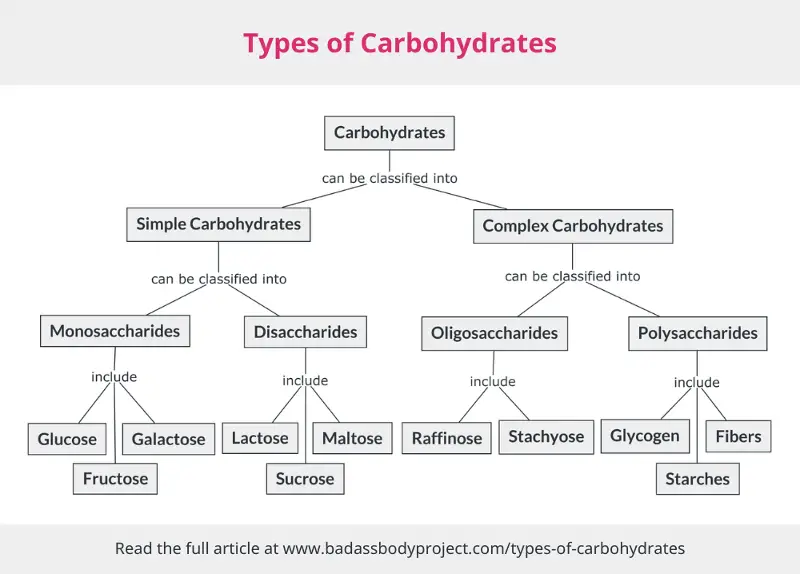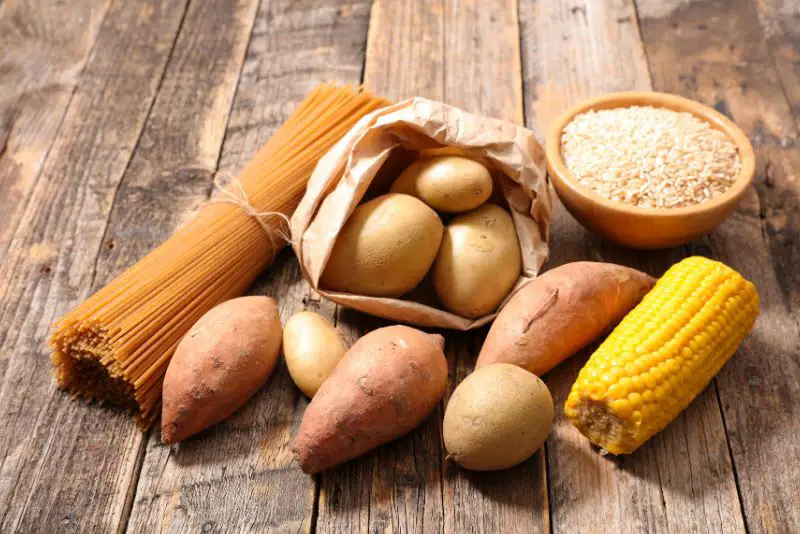These days, carbohydrates have a pretty bad reputation for causing weight gain, obesity, and all sorts of health issues. But they’re also one of the macronutrients that your body needs. In this article, we’ll dive into the different types of carbohydrates to get to know them better.
So, what exactly are carbohydrates? Well, they’re chemical substances, just like other nutrients. The term “carbohydrate” itself means “hydrated carbon,” which describes the atoms it’s made up of. And those atoms are carbon, hydrogen, and oxygen.
Based on their chemical structure, carbohydrates can be divided into two main types: simple carbohydrates and complex carbohydrates. Each of these types has its own subgroups. Simple carbohydrates include monosaccharides and disaccharides, while complex carbohydrates include oligosaccharides and polysaccharides.
Table of Contents
- Simple Carbohydrates
- Complex Carbohydrates
- Digestion and Absorption of Carbohydrates
- Closing Remarks
Simple Carbohydrates
Simple carbohydrates, also known as sugars, have a simple chemical structure. They can be classified into two types: monosaccharides and disaccharides.
A. Monosaccharides
The term monosaccharide is a combination of “mono,” which means “one,” and “saccharide,” which means “sugar.” Monosaccharides are carbohydrates made up of just one sugar molecule. The main monosaccharides found in foods are glucose, fructose, and galactose.
1. Glucose
Glucose, also known as “blood sugar,” is the most common monosaccharide. However, it’s seldom found in isolation within foods; it typically exists as part of disaccharides or complex carbohydrates. Glucose plays a vital role in providing energy to your body, especially for your brain, nerves, and red blood cells.
2. Fructose
Fructose is the sweetest monosaccharide. It naturally occurs in fruits and honey. It’s also present in high-fructose corn syrup, which then finds its way into various processed foods and beverages that use the syrup, like cereals, soft drinks, and candies.
3. Galactose
Similar to glucose, galactose is rarely found in isolation within foods. It’s typically found as part of lactose, which is the main carbohydrate in milk.
B. Disaccharides
Disaccharides are carbohydrates formed by the bonding of two monosaccharide molecules. The term “di” in disaccharide means “two.” The main disaccharides found in foods are lactose, sucrose, and maltose.
1. Lactose
Lactose is composed of one glucose molecule and one galactose molecule. It serves as the main carbohydrate in milk. The term “lac” in lactose means “milk.” It’s also commonly referred to as “milk sugar.”
2. Sucrose
Sucrose consists of one glucose molecule and one fructose molecule. Due to its fructose content, sucrose is considered the sweetest disaccharide. It occurs naturally in various fruits and vegetables. The white or brown sugar we typically consume is refined from sucrose obtained from sugarcane or sugar beets.
3. Maltose
Maltose is made up of two glucose molecules. It’s rarely found in isolation within foods. Maltose primarily arises as a result of starch digestion in the body. It also occurs during the fermentation process in the production of alcoholic beverages.
Complex Carbohydrates
Complex carbohydrates are carbohydrates made up of three or more monosaccharides. They fall into two categories: oligosaccharides and polysaccharides.
A. Oligosaccharides
Oligosaccharides are carbohydrates composed of 3 to 10 monosaccharides. The term “oligo” in oligosaccharide means “several.” The most common oligosaccharides found in foods are raffinose and stachyose.
1. Raffinose
Raffinose consists of a glucose molecule, a fructose molecule, and a galactose molecule. You can find it in cabbage, Brussels sprouts, broccoli, whole grains, and beans.
2. Stachyose
Stachyose consists of two galactose molecules, a glucose molecule, and a fructose molecule. It’s commonly found in various legumes.
B. Polysaccharides
Polysaccharides are carbohydrates that contain numerous (hundreds or thousands) glucose molecules, sometimes along with other monosaccharides. The term “poly” in polysaccharide means “many.” The key polysaccharides found in foods are glycogen, starches, and fibers.
1. Glycogen
Glycogen serves as the storage form of glucose in animals and humans. It’s not present in plants. However, when an animal passes away, enzymes break down its glycogen. So, there’s very little glycogen left in the meat. Most glycogen in your body is produced by your body from excess glucose, rather than coming directly from food.
2. Starches
Similar to glycogen in animals and humans, starch is the storage form of glucose in plants. There are two types of starch: amylose and amylopectin. Amylopectin is digested more quickly, leading to a faster increase in blood glucose compared to amylose.
Starchy foods include grains (such as wheat, rice, and corn), tubers (like potatoes and yams), and legumes (such as beans and peas).
3. Fibers
Fiber constitutes the skeletal structure of plants, so it’s exclusively found in plants. While not all fibers are polysaccharides, most of them are.
Due to their molecular structure, most fibers are indigestible. They pass through your digestive system without being digested and absorbed by your body. Hence, they contribute little to no energy. However, they offer numerous health benefits.
Some fibers, though, are fermentable. They can be fermented and digested by bacteria in your colon. Based on their solubility in water, fibers can be classified into soluble and insoluble fibers. Soluble fibers are generally more fermentable compared to insoluble fibers.

Digestion and Absorption of Carbohydrates
When discussing carbohydrates, it’s important to understand how your body digests and absorbs them. In this section, we’ll explore the process of digestion and absorption of carbohydrates.
Carbohydrate digestion kicks off in your mouth. As you chew starchy foods, an enzyme called amylase in your saliva breaks down starch into maltose. However, disaccharides are not digested in the mouth.
The mouth isn’t the main site of carbohydrate digestion since the food quickly moves on to the stomach. Once in the stomach, stomach acid deactivates the salivary amylase enzyme. No carbohydrate digestion takes place in your stomach.
Carbohydrate digestion resumes once the food reaches your small intestine. This is where most carbohydrate digestion occurs. Here, pancreatic amylase breaks down the remaining starch into maltose.
Subsequent enzymes break down maltose and other disaccharides into monosaccharides. Maltase splits maltose into two glucose molecules, sucrase breaks down sucrose into fructose and glucose, and lactase breaks down lactose into galactose and glucose.
These monosaccharides then enter the bloodstream and travel to the liver. In the liver, most non-glucose monosaccharides are converted into glucose. If your body needs immediate energy, glucose is sent to your cells. If not, glucose is stored as glycogen in the liver, muscles, and brain.
Keep in mind that glycogen storage is limited. It can only provide energy for about a day or less. Once the storage limit is reached, any excess glucose will be stored as fat.
As for fiber, most fibers are indigestible by your body. They just pass through the digestive system and end up being excreted. However, certain fibers can be fermented by bacteria in your colon, resulting in the production of gas, water, and short-chain fatty acids.
Since most fibers are indigestible, they do not contribute significant energy to your body. Fermented fibers provide only a small amount of energy, approximately 1.5 to 2.5 calories per gram. Nonetheless, fiber offers numerous health benefits, such as preventing constipation and reducing blood cholesterol levels.
Another group of carbohydrates that is difficult to digest is FODMAP, which stands for fermentable oligosaccharides, disaccharides, monosaccharides, and polyols. Raffinose and stachyose, mentioned earlier, are examples. Both are fermented by bacteria in the large intestine.
Closing Remarks
The classification of carbohydrates discussed earlier is based on their chemical structure, which is commonly done in nutrition science. However, carbohydrates can also be classified in other ways. For instance, MedlinePlus and the American Diabetes Association classify carbohydrates into sugars, starches, and fiber.
No matter how you classify them, carbohydrates end up in your body as glucose and fiber. Consuming too much glucose is associated with health issues like diabetes and obesity, while fiber offers numerous health benefits.
The general recommendation is to prioritize carbohydrates that are rich in fiber. However, this doesn’t mean simply excluding certain foods or only consuming specific ones. Many carb-rich foods contain multiple types of carbohydrates. For example, fruits contain both sugar and fiber. It’s a good idea to vary your carb sources to get a good mix of nutrients.
Thompson, J. L., Manore, M. M., & Vaughan, L. A. (2017). The Science of Nutrition (4th ed.). Pearson Education.
Whitney, E., & Rolfes, S. R. (2019). Understanding Nutrition (15th ed.). Cengage Learning.

Sasha Lizaveta is a fitness enthusiast and content manager at BadassBodyProject.com. She advocates a conservative yet effective approach to fitness. She believes in the power of gradual changes to achieve long-lasting results. When not working out or creating content, she can often be found engrossed in books, playing with her cats, or travelling.

